This Sautéed Collard Greens recipe offers a simple yet satisfying method that brings out the hearty and savory flavor of the greens, making them a flavorful addition to any meal. Combined with homemade Creole seasoning, aromatic garlic, onions, and a touch of olive oil, these tender greens are gently cooked to perfection, resulting in a dish that's as wholesome as it is delicious.
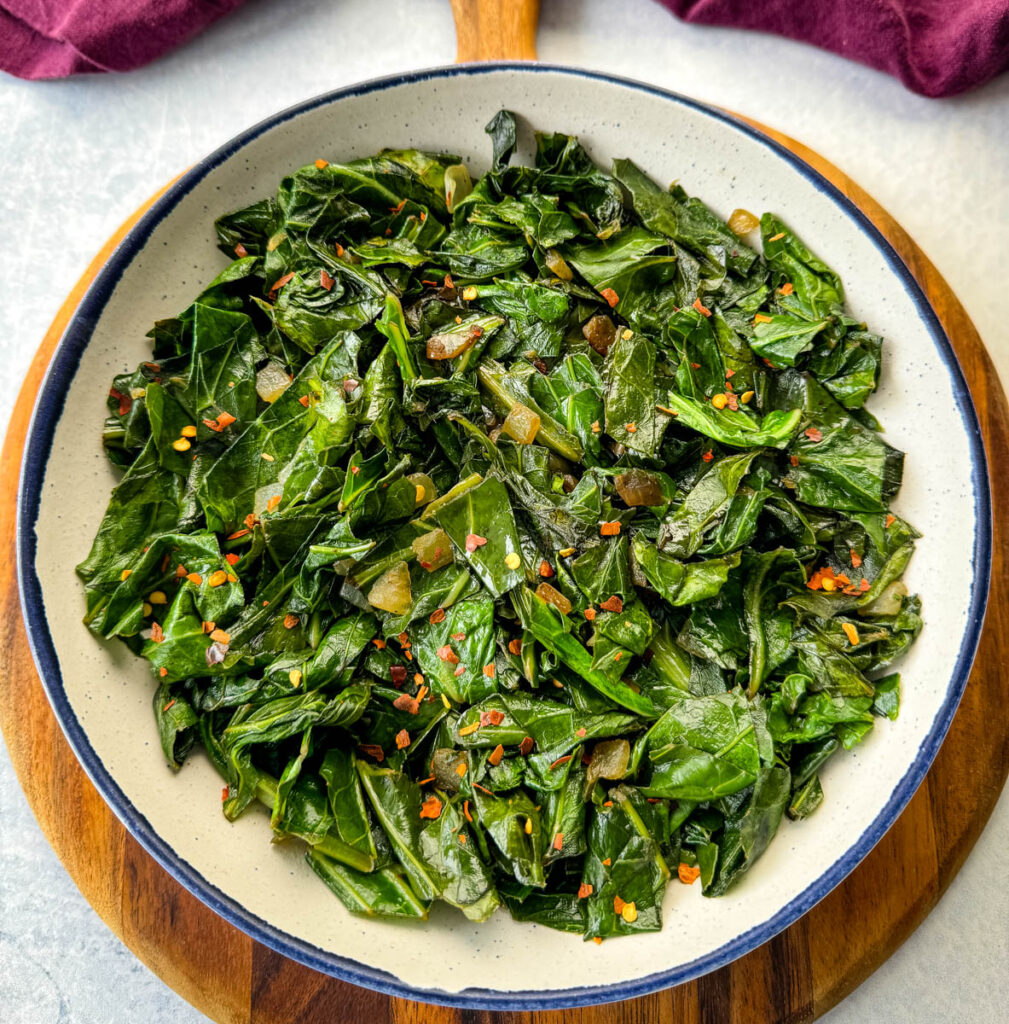
Want to save this recipe for later?
Table of Contents
Why You Will Love This Recipe
- Quick and Easy Preparation: Sautéing collard greens is a quick and straightforward way to prepare them, making it a convenient option for busy weeknights or when you need a simple side dish in a hurry.
- Enhanced Flavor: When you prepare the dish this way, the greens will cook quickly in a hot pan with flavorful add-ins like garlic, onions, and you can even toss in bacon.
- Tender Texture: This method preserves their natural texture while still making them tender and easy to eat.
- Versatility: The greens can be served as a simple side dish alongside a variety of main courses, such as Dry Rub Chicken Wings, Baked Turkey Legs, or Slow Cooker Crockpot Pot Roast. They can also be incorporated into other recipes, such as pasta dishes, soups, or rice bowls.
- Nutritional Benefits: Collard greens are highly nutritious and packed with vitamins, minerals, and antioxidants. Greens are a great vegetable side dish.
How to Shop for Collard Greens
The first thing to consider is whether you plan to buy the large leafy (standard) collard greens or pre-cut options. Some grocery stores offer pre-cut or pre-washed collard greens for convenience. While these can save time in the kitchen, be sure to check the quality and freshness of the pre-cut greens before purchasing.
Sometimes these pre-washed packages include a lot of stems which often reduces the amount of actual leafy greens you get in the package. When using these, I often purchase more (in weight) than I need to ensure I have enough greens for the meal.
Here are some things to consider when shopping:
- Choose Fresh Greens: Look for collard greens that are fresh and vibrant in color, with crisp, dark green leaves. Avoid any greens that are wilted, yellowing, or have brown spots.
- Check the Stems: Examine the stems of the greens to ensure they are firm and not woody or fibrous. Tender stems indicate younger, more tender greens.
- Consider Organic Options: If possible, opt for organic greens to reduce exposure to pesticides and other chemicals.
- Select the Right Quantity: Depending on how many people you plan to serve and how you intend to use them, choose the appropriate quantity of greens. One bunch of collard greens typically serves 2-4 people, depending on the size of the bunch and how they are prepared.
- Check for Pests: Inspect the leaves of the greens for any signs of pests, such as holes or chewed edges. While a few minor imperfections are normal, avoid greens that are heavily damaged by pests.
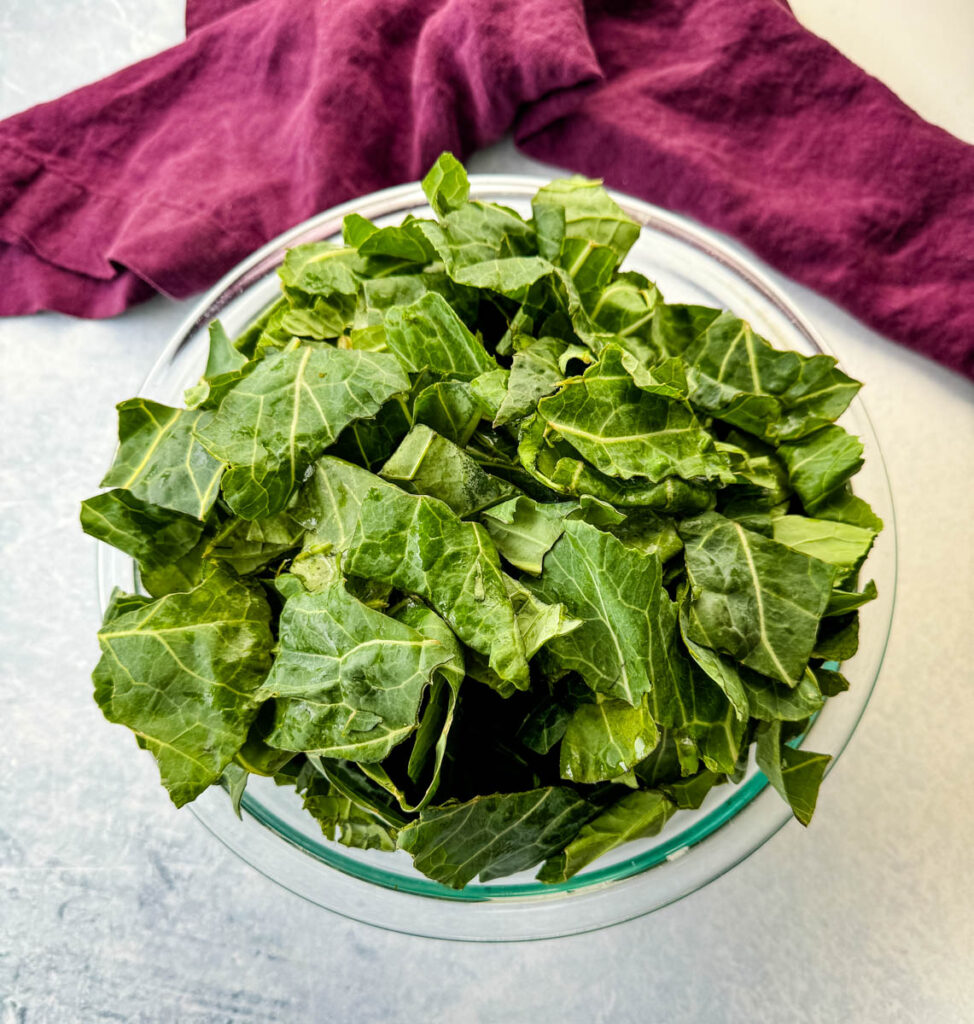
How to Wash Greens
Washing the greens is an essential step to remove any dirt, debris, or pesticide residues that may be present on the leaves. Here's how to wash them effectively:
- Fill a Sink or Large Bowl with Cold Water: Start by filling a clean sink or a large bowl with cold water. You'll need enough water to fully submerge the greens.
- Separate the Leaves: Remove the greens from their bunch and separate the leaves from the stems. Discard any damaged or yellowing leaves.
- Submerge the Leaves in Water: Submerge the collard green leaves in the cold water bath, allowing them to soak for a few minutes. Swirl them around gently with your hands to help loosen any dirt or debris.
- Inspect the Leaves: After soaking, lift the greens out of the water and inspect them for any remaining dirt or grit. If you notice any, repeat the soaking process with fresh water until the leaves are clean.
- Rinse Under Running Water: After soaking, rinse each leaf individually under cold running water. Hold the leaves under the faucet and rub them gently with your fingers to remove any remaining dirt or debris.
- Pat Dry or Use a Salad Spinner: Once the greens are clean, you can either pat them dry with clean kitchen towels or use a salad spinner to remove excess moisture. If using a salad spinner, spin the leaves in batches until they are dry.
- Trim and Chop as Desired: After washing and drying, chop the leaves into small strips.
Use the clean, washed greens immediately or store them properly in a clean, airtight container or produce bag in the refrigerator for later use. They will last properly covered and sealed for a few days.
Spices and Flavor
I like to use my Homemade Collard Greens Seasoning which is very similar to Creole Seasoning. Feel free to use store-bought Creole Seasoning if you wish.
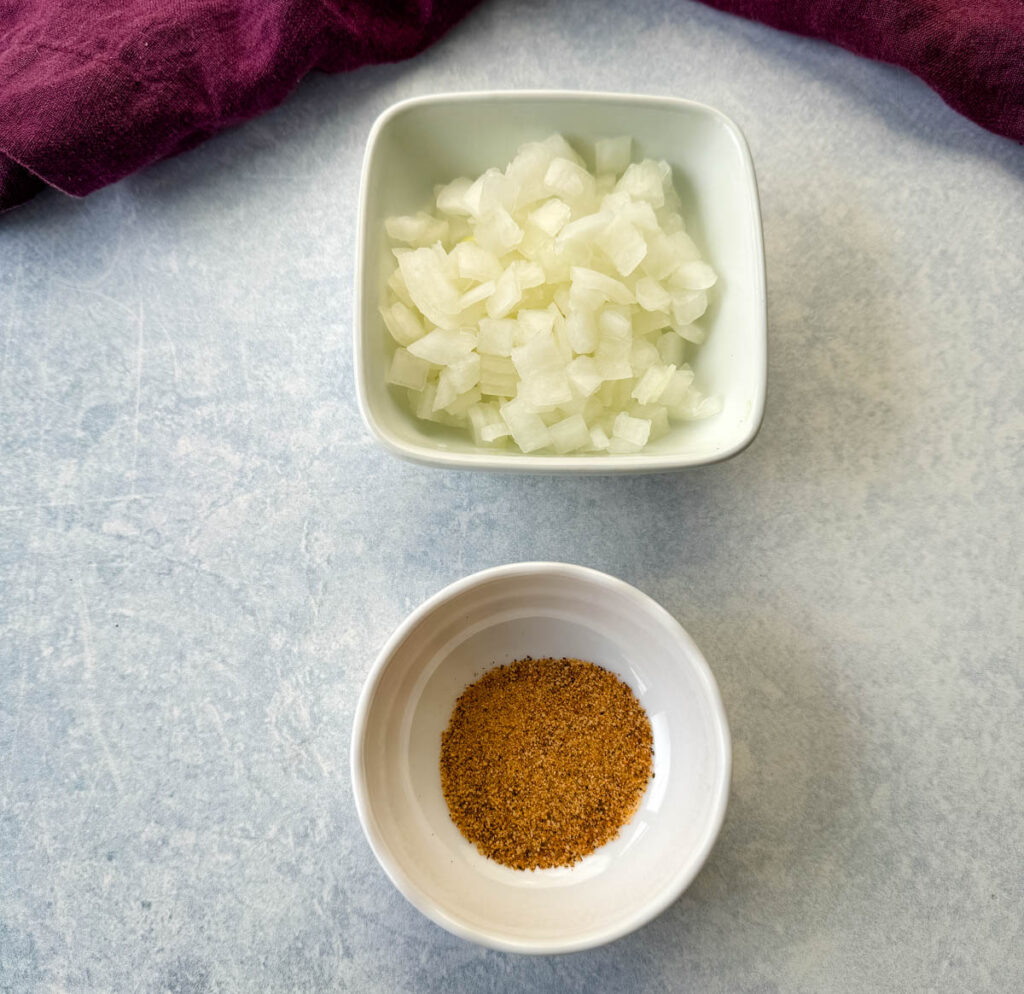
How to Make Sautéed Collard Greens
Detailed measurements and full instructions can be found in the recipe card at the bottom of this post.
- Wash the greens.
- Heat a pan on medium heat with olive oil.
- Add in onions and garlic and cook until the onions and garlic are fragrant.
- Layer in the collard greens and allow them to wilt. Sprinkle the spices throughout.
- Stir and cook until the collards are tender.
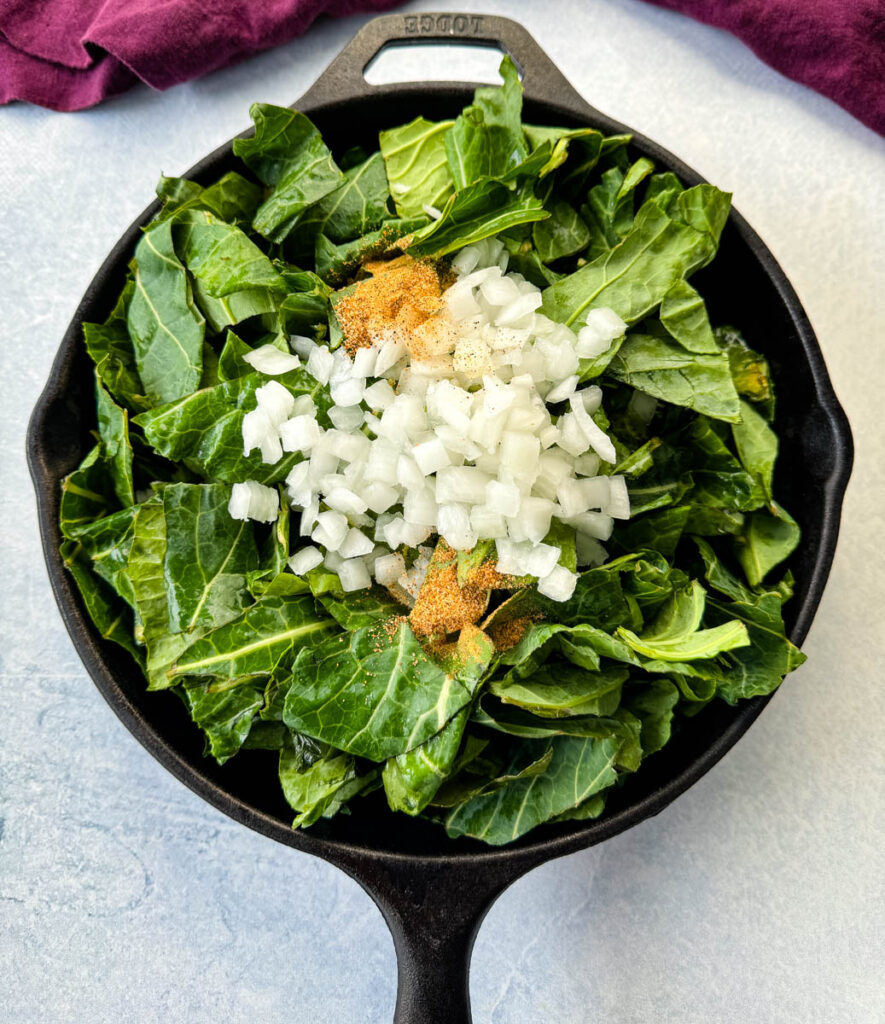
What Type of Pan to Use
it's best to use a large, heavy-bottomed skillet or frying pan. Here are a few options to consider:
- Cast Iron Skillet: Cast iron retains heat well and distributes it evenly, helping to cook the greens evenly and develop a nice sear. Plus, cooking in cast iron can add a subtle depth of flavor to the dish.
- Stainless Steel Skillet: It heats evenly and allows for precise temperature control, making it ideal for cooking greens quickly and evenly.
- Non-Stick Skillet: A non-stick skillet is convenient as it requires less oil and makes cleanup easier. However, be mindful not to use high heat with non-stick pans, as excessive heat can damage the non-stick coating.
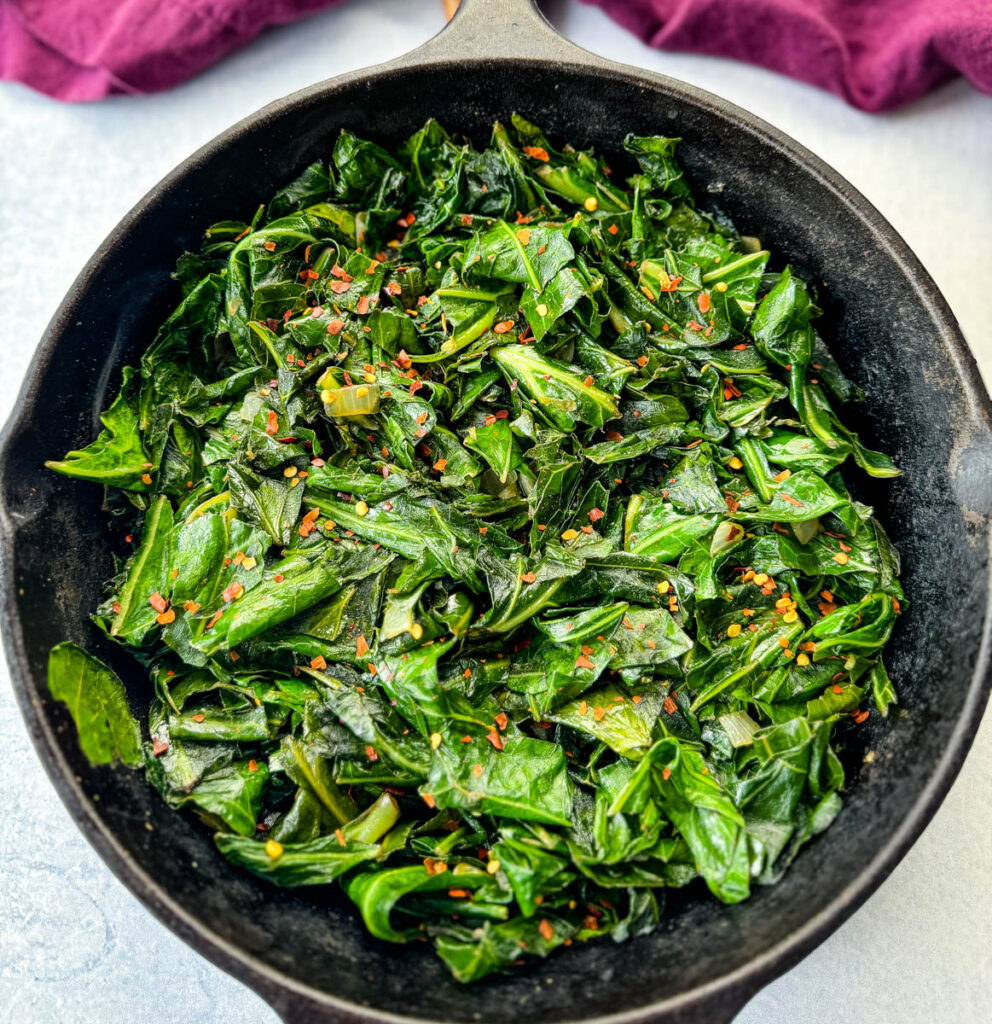
How to Add Bacon
You can slice the bacon into chunks (a few slices works well) and add it to the pan when you saute.
Bitter Greens
I find that adding Creole seasoning gives the collards amazing flavor. If they are still bitter to you, I recommend adding bacon and reading the notes above. Some people also add sugar or sweetener and/or vinegar to their greens to reduce bitterness.
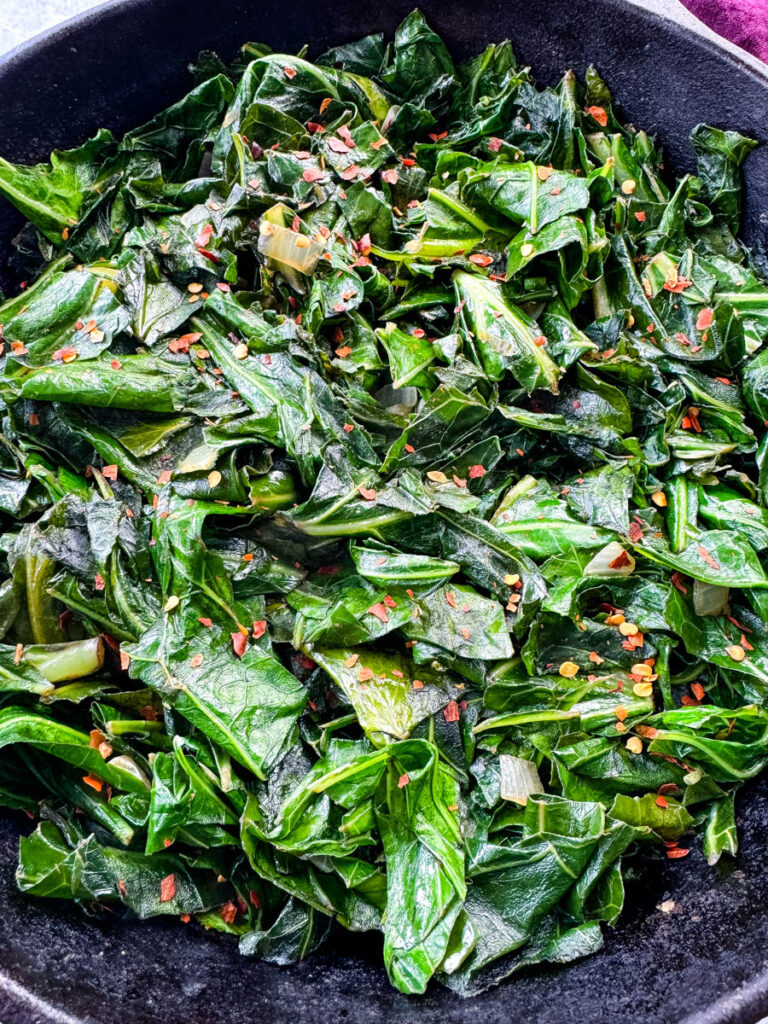
How to Store
You can store the dish tightly covered and sealed in the fridge for 3-4 days.
How to Reheat
You can reheat the dish on the stove or in the oven (at 350 degrees) until warm. You can also use the microwave on high power in 1-minute increments, stirring between each interval, until the greens and peas are heated through.

Pair With These Recipes
Southern Soul Food Cornbread
Southern Soul Food Baked Mac and Cheese
Southern Soul Food Mustard Greens
Baked Turkey Wings
Smothered Turkey Wings
Southern Candied Sweet Potatoes
Southern Cooked Cabbage
Ham Hocks and Beans
Cajun Seafood Gumbo with Shrimp and Crab
More Greens Recipes
Southern Soul Food Collard Greens with Smoked Turkey
Mixed Greens
Black Eyed Peas and Collard Greens
Southern Turnip Greens
Slow Cooker Crockpot Collard Greens
Southern Soul Food Mustard Greens
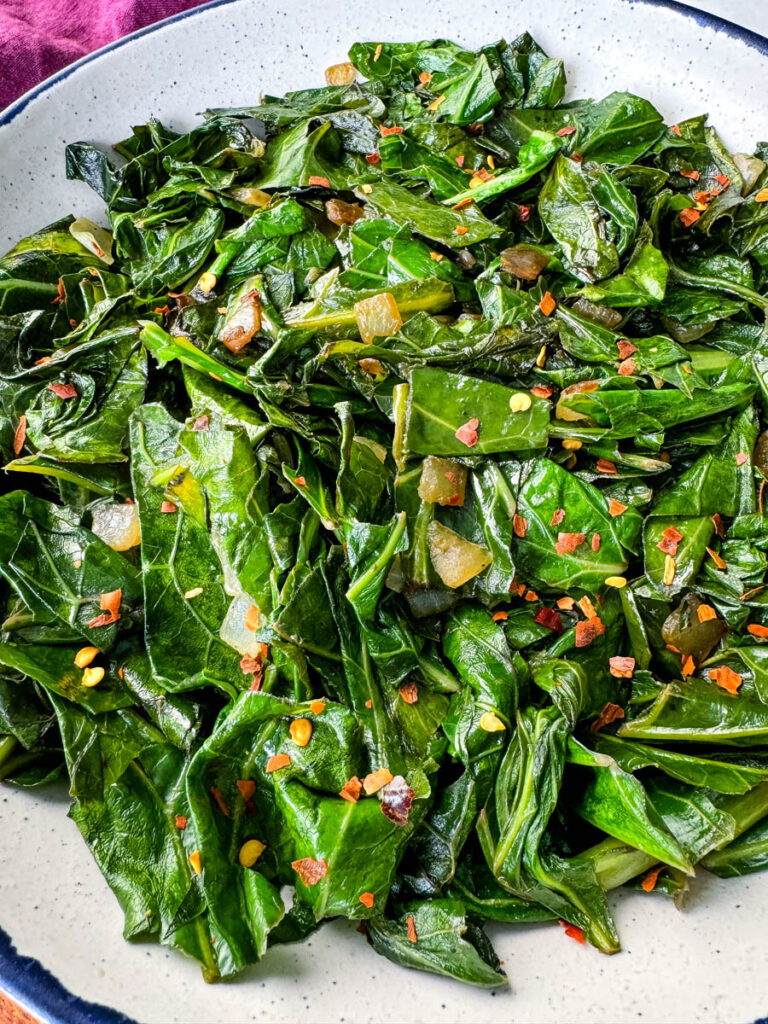
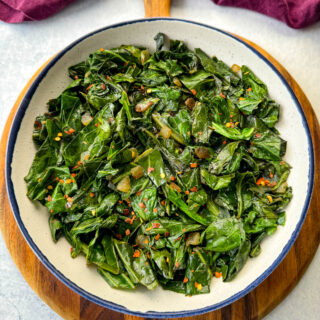
Sautéed Collard Greens
Want to save this recipe for later?
Equipment
Ingredients
- 1-2 pounds fresh collard greens
- 1 teaspoon olive oil
- ½ cup chopped white onions
- 2 garlic cloves Minced.
- 1-2 teaspoons Creole Seasoning Adjust to taste.
- crushed red pepper Optional; season to taste.
Instructions
- Fill a large bowl or your sink with water. Use your hands and scrub the veins of the leaves to remove any dirty or sand. Wash the greens thoroughly until the water runs clear.
- Remove the stems from the greens and slice the greens into smaller pieces.
- Heat a pan (I use a 10 inch cast iron skillet) on medium heat with the olive oil.
- Add in the onions and garlic and cook for 2-3 minutes until the onions and garlic are fragrant.
- Layer in the collard greens and allow them to wilt. Sprinkle the spices throughout.
- Stir and cook until the collards are tender, about 10-15 minutes. Taste repeatedly and adjust the spices as necessary.
Notes
Nutrition
Nutrition Data
Macros are provided as a courtesy and should not be construed as a guarantee. This information is calculated using MyFitnessPal.com. To obtain the most accurate nutritional information in a given recipe, you should calculate the nutritional information with the actual ingredients used in your recipe, using your preferred nutrition calculator. You are solely responsible for ensuring that any nutritional information provided is accurate, complete, and useful.

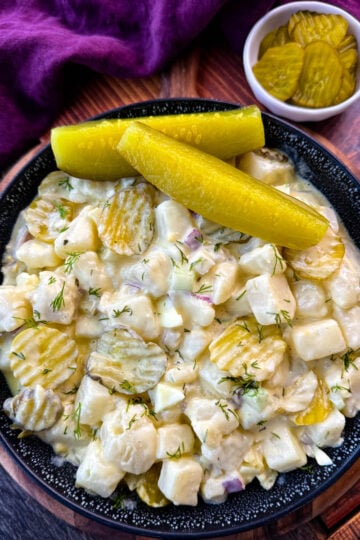
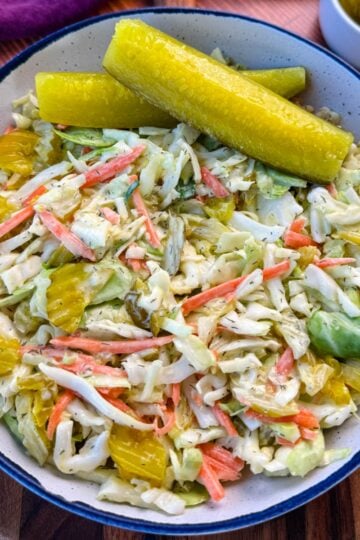

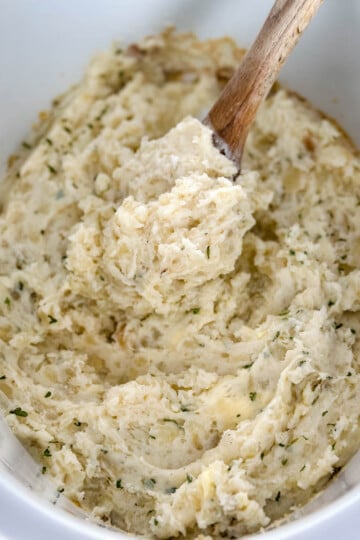
Leave a Reply